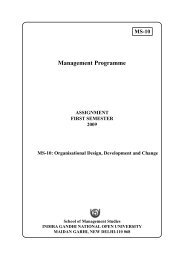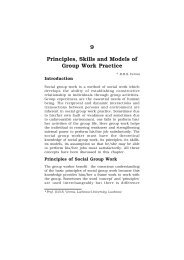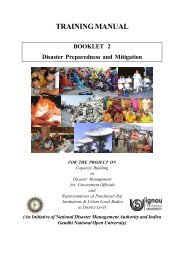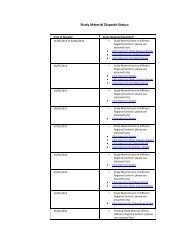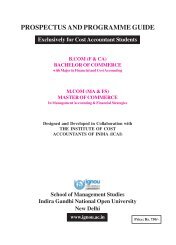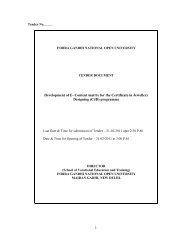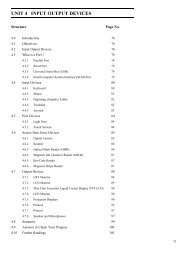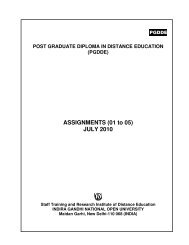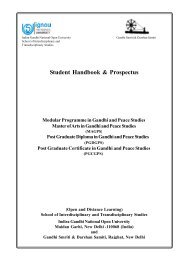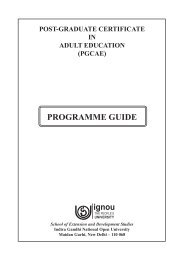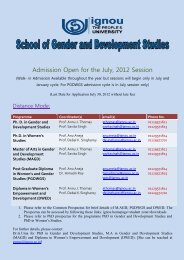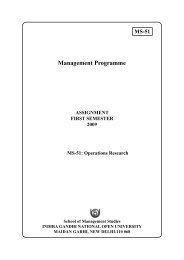PROSPECTUS AND PROGRAMME GUIDE - IGNOU
PROSPECTUS AND PROGRAMME GUIDE - IGNOU
PROSPECTUS AND PROGRAMME GUIDE - IGNOU
Create successful ePaper yourself
Turn your PDF publications into a flip-book with our unique Google optimized e-Paper software.
2. Capital Budgeting Decisions<br />
Planning and control of capital expenditure; capital budgeting process; techniques of capital budgetingdiscounted<br />
and non-discounted cash flow methods, choice of methods; capital rationing; risk evaluation<br />
and sensitivity analysis, simulation for risk evaluation; linear programming and capital budgeting decisions.<br />
3. Capital Structure Decisions<br />
Meaning and significance of capital structure; capital structure vis-a-vis financial structure; capital structure<br />
planning and designing; optimal capital structure; determinants of capital structure; capital structure and<br />
valuation - theoretical analysis; EBIT – EPS analysis; cost of capital; factors affecting cost of capital,<br />
measurement of cost of capital, weighted average cost of capital, marginal cost of capital; risk and leverage;<br />
measures of leverage, leverage effects on shareholders returns.<br />
4. Sources of Finance<br />
Equity, non-voting preference shares; debentures and bonds; company deposits; term loans from financial<br />
institutions and banks; international finance and syndication of loans; euro-issues and external commercial<br />
borrowings; FCCB; internal funds as a source of finance; dividend policy and retention of profits; bonus<br />
shares; deferred payment arrangements; corporate taxation and its impact on corporate financing; financing<br />
cost escalation.<br />
5. Dividend Policy<br />
Introduction; types, determinants and constraints of dividend policy; different dividend theories — Walter’s<br />
Model, Gordon’s Model and Modigliani-Miller Hypothesis of dividend irrelevance; forms of dividend; dividend<br />
policy - practical considerations and legal constraints; corporate dividend practices in India; statutory<br />
framework.<br />
6. Working Capital Management and Control<br />
Working capital - meaning, types, determinants; assessment of working capital requirements - operating<br />
cycle concept and applications of quantitative techniques; management of working capital - cash, receivables,<br />
inventories; financing of working capital; banking norms and macro aspects of working capital management.<br />
7. Security Analysis and Portfolio Management<br />
Security analysis - fundamental approach, technical approach and efficient capital market theory; portfolio<br />
management - meaning, objectives; portfolio theory – traditional approach; modern approach - CAPM model.<br />
8. Financial Services<br />
Meaning, significance and scope of financial services; types of financial services – merchant banking,<br />
leasing and hire purchase, venture capital, mutual funds, factoring and forfeiting, securitisation of debt,<br />
loan syndication, custodial and corporate advisory services, credit rating.<br />
9. Project Planning and Control<br />
Project Planning and preparation of project report; project appraisal under normal, inflationary and deflationary<br />
conditions; project appraisal by financial institutions – lending policies and appraisal norms by financial<br />
institutions and banks; loan documentation and loan syndication, project review and control; social cost<br />
and benefit analysis of project.<br />
10. Derivatives and Commodity Exchanges<br />
Concept of derivatives; financial derivatives and commodity derivatives; types of derivatives - forward<br />
contracts, futures contracts, options; participants in futures and options market, Index based derivatives<br />
and security based derivatives; derivatives and exposure management, currency forwards, currency futures,<br />
currency options and currency swaps and interest rate risk management; derivative markets in India;<br />
commodity exchanges in India.<br />
11. Treasury Management<br />
Meaning, objectives, significance, functions and scope of treasury management; relationship between treasury<br />
management and financial management; role and responsibilities of chief finance executive; tools of treasury<br />
A-46



